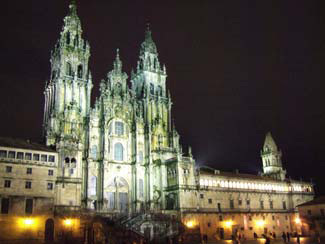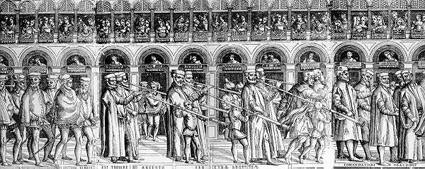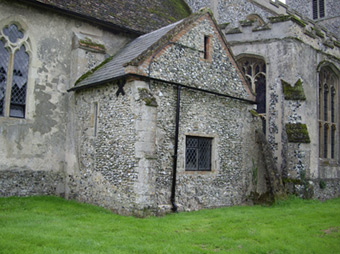Institute for Advanced Studies
Symposium 1 – Friday 25 April 2008
‘No longer prepared to pay homage to ritual’s over-confident declaration of form against indeterminacy, the scholar finds that the very condition of indeterminacy lies at the heart of ritual form. It is only in performance – in those very moments when ritual actions unfold – that such a paradox becomes apparent, and it is only by recognizing this paradox that the real dynamism and transformative potential of ritual can be grasped and appreciated.’
Gavin Brown, ‘Theorizing Ritual as Performance: Explorations of Ritual Indeterminacy,’ Journal of Ritual Studies 17:1 (2003), 3-16 (p.16).
10.15-11.15 Professor Kathleen Ashley (University of Maine), editor of Ritual Studies
‘Anthropologists Speaking of Ritual’, Presentation and discussion
11.30-12.15 ‘Improvising Ritual on the Pilgrimage to Santiago’ (Professor Kathleen Ashley)
1.30-2.30 Dr Axel Klein (University of Kent)
“Arrested liminality – problematic drug use as a failed process of initiation”
2.45-3.45 Robert Segal (University of Aberdeen)
“The Shift from Action to Belief: The Course of Modern Theories of Religious
Ritual”
It was the Victorian Semiticist William Robertson Smith who first argued that ritual, not belief, was the heart of ancient and “primitive” religion. For him, belief remained the heart of modern religion. Since his time, ever more theorists of religion have come to deem ritual the core of all religion. Belief, especially when formalized as creed, has come to be seen as abstract and artificial, as the religion of philosophers and theologians. Ritual has come to be embraced as folk religion, as religion as it is lived. Most anthropologists and sociologists today view religion as ritual first and belief second. But what has also changed is the characterization of ritual itself. Ritual has come to be seen ever less as distinct from belief and ever more as part of belief. Even though ritual has remained action, that action has come to be regarded as the expression of belief and even as the instillment of belief. Rather than succeeding belief as the heart of religion, ritual has come to subsume belief under itself.
3.45-4.00 Hendrik Schulze, ‘RitualDynamik’ at Heidelberg University
Symposium 2
Monday 9 June 2008
Professor Edward Muir (Northwestern University)
” Seeing Through Rituals”
What does sight have to do with the power of rituals? Or, to put the question more precisely, how did people see during processions, what did they see in processions, and how did people understand what they saw? This paper examines the two persistent structural features of western rituals: an organized procession of persons bearing sacred objects through a community and a pilgrimage of members of a community to a shrine, which they frame with signs of their devotion, especially candles and ex votos. During the later Middle Ages and Renaissance, these two structures, distinguished from other peregrinations by the gestures employed, created ritual-specific ways of seeing, which I want to explore in this paper. The paper makes three arguments:
First, late medieval optical theories suggested that the viewers of rituals were brought under the influence of what they saw through a profusion of material or spiritual emanations or, to put it in their terms, through the radiation of species. A ritual, especially an ecclesiastical or official procession, attempted to irradiate viewers with beneficent spiritual or authoritarian influences.
Second, the spectators of a ritual procession were simultaneously being viewed by those who marched in it so that the seeing subject and seen object were, in fact, interchangeable. Much more significantly than a liturgical celebration at the altar or a baptism at the font, a procession through the streets of a town blurred the subject/object distinction, which is also one of the sources for processions’ dangerous social potential to metamorphose from ritual order to ritual riot. Spectators in the act of spectating became just as much a part of the procession or pilgrimage as the processors themselves, and the mutual influences between processors and spectators produced by sight created a certain creative, improvisational unpredictability to processions and pilgrimages.
Third, the kinetic character of rituals, which were effectively improvisations on a loose script, makes it impossible to affix a single meaning to a specific ritual performance. Rituals created a peculiar oxymoron: they were performances that always varied from one repetition to another but that attempted to mask variation by asserting their unchanging character. I wish to suggest that the struggle to affix a consistent meaning to ritual was a vain quest because it is the very defiance of uniform meaning while evoking powerful emotions that produces the lure of ritual.
11.00-11.15 Group discussion
11.30-12.30 Dr Christina Pössel ( Dept Medieval History, University of Birmingham)
“The Magic of Medieval Ritual”
12.30-1.45 Lunch
1.45-2.45 Dr Felicia Hughes-Freeland (Swansea University)
“Divine cyborgs? Ritual spirit presence and the limits of media”
In a mountain village in Java, members of a troupe of horse dancers prepare to go into a possession trance. The anthropologist has been invited to film the event, and has charged all her spare batteries, and has also equipped herself with a stills camera and tape recorder. The moment the trance begins, all the visual technology breaks down. The divine cyborgs resist entextualization mediated by ‘modernity’s mimetic machinery’ (Taussig 1993: 242).
Anthropologists often experience problems when they try to reproduce the visual appearance of powerful events such as ritual performance. I conceptualise the possessed dancers as ‘divine horsemen’ (the title of Maya Deren’s film aboutpossession in Haiti) but also as cyborgs, as discussed by feminist anthropologist Donna Haraway. The analogy between the idiom of possession and the concept of the cyborg is used to examine the relationship between embodied human nature, ritual instrumentality, in the age of science, technology, and media. I also draw on Michael Taussig’s work on the mimetic power of spirits as within the modern but magical state to ask how we can characterize the embodying presence of this ‘other’, and what this sense of ‘embodying’ might tell us about the relationship between performance and religion, and the positioning of the human between animals on the one hand and the machine on the other. Local Javanese discourses show that the ‘other’ is a literal version of reality, not just a symbolic displacement. Neurological research into the power of sound and its intimate connection with emotion also challenges the primacy of sight in the hierarchy the human responses to sense data. This suggests that discourses and experiences of possession mark a limit to which ritual experience can be recuperated into rational explanations and reproduced for circulation by media technologies.
2.45-3.00 Group discussion
3.15-4.15 Dr Liz Herbert-McAvoy, (Swansea University)
“‘Anchoresses [. . .] bien more streytly closed…’: Gender, Space and the Medieval Anchorite”
This paper examines how gender and space are constructed and interact in a range of fourteenth-century texts written for or about an anchorite – or medieval recluse. Firstly it will focus on the anonymous male-authored Speculum Inclusorum (written specifically for an enclosed monastic audience)and its Middle English translation, the Myrour of Recluses. It will then concentrate on a brief letter written to a newly enclosed monastic anchorite, ‘Dominus L’, by the Abbot of his Benedictine community in Bury (St Edmunds). Finally, it will turn to a series of three letters written by the powerful bishop John de Stratford concerning the enclosure, and re-enclosure of the young Surrey anchoress, Christina Carpenter. Examining aspects of the imagery and rhetoric in each case, it will argue for a markedly different investment by church and community in the medieval anchorite depending on his/her sex, gender and spatial interactions. In so arguing I will hope to raise a number of questions regarding the role of ritualistic activity and practices within anchoritic life and discourse, and how these are enhanced or subverted by the interplay of gender and space both within and without the text.
Participants from Lancaster
Prof Michael Mullett (History)
Prof Andrew Jotischky (History)
Prof Meg Twycross (Medieval Lit)
Prof Alison Findlay (Renaissance Drama)
Dr Robert Appelbaum (Early Modern French and English Lit.)
Dr Liz Oakley-Brown (Early Modern English Literature)
Prof Gerry Harris (Theatre Studies)
Dr Carl Lavery (Theatre Studies)
Dr Edward Venn (Music)
Dr Bogdan Costea (Work Organisations and Management)
Dr Fiona Measham (Sociology, Criminology)
Dr Karenza Moore (Sociology, Criminology)
Dr Andrew Tate (English)
Dr Jayne Steel (English)
Prof John Schad (English)
Susan Phillips (Theatre Studies)
Tom Roberts (Sociology)
Visits by a member of the University of Heidelberg’s interdisciplinary ‘Ritualdynamik’
Project to Lancaster, and by Dr Oakley Brown and Dr Edward Venn (Dept. Music, LICA), to give papers at the 2008 ‘Ritualsynamik’ Conference, form the beginnings of collaboration with the Heidelberg group.



